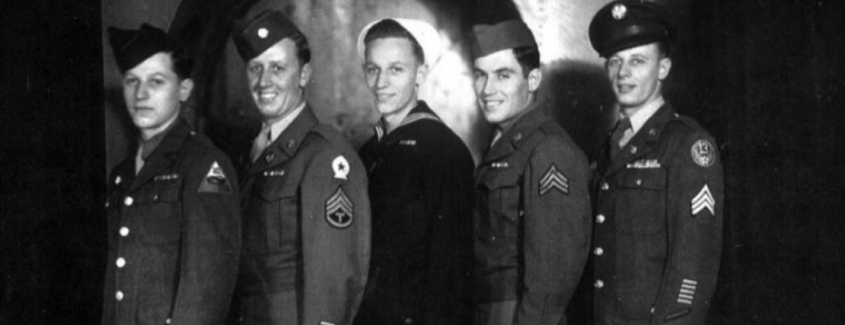
Five years ago, for Memorial Day 2014, I wrote about the five Bailey brothers of World War II. This year, I’m writing about them maybe for the last time.
Yes, there were no less than five Baileys who served in WWII. That fact is known to those who attend the annual Memorial Day parade in Mercer, Pennsylvania. The parade is pure Americana: local rotary club, high-school bands, church groups, veterans of wars.
The veterans marching today largely wear the camouflage of distant regions like Iraq and Afghanistan, or uniforms from Vietnam and Korea. Veterans from World War II, unfortunately, are a dwindling sight. I wonder if we’ll see any this year.
One exhibit has long been part of the procession: a classy old car with a placard announcing the “Five Bailey Brothers.”
Back in 2013, after several years of watching the Bailey car ride by, I took the time to track down the last surviving brother: Dick. I was pleasantly surprised to learn he lived in my town—Grove City. I called and asked if he’d give me some time to hear and write about him and his family. He agreed.
Born Christmas Eve 1922, Dick served in World War II along with his brothers Fred, Alphonse (known as “Fonnie”), Jim, and John. All five volunteered after Pearl Harbor and were dispatched into enemy territory. “All had combat,” says Dick—in Europe, the Pacific, Northern Africa; land, sea, air.
Fred was shot and taken prisoner by the Nazis. “The Germans didn’t treat him well,” Dick told me. “Fred said it was horrible…. He was only 110 pounds when he came home.” He won a purple heart.
Dick was in the Army Air Corps. He and his brother John were in the war the longest. Dick served on six Pacific islands. In the Schouten Islands, the Japanese bombed almost every night, typically two hours at a time, throughout Dick’s eight-month stay. “You didn’t sleep very much,” remembered Dick.
In all, Dick served continuously from December 1942 until January 1946: “I was never home the whole time until January 1946.”
I asked Dick about the moment he finally got home. It was the winter of 1946. For weeks, he sojourned from the other side of the earth, only to encounter a terrific snowstorm as he neared Western Pennsylvania.
He took the train from Pittsburgh to Grove City. Unbeknownst to Dick, his parents had moved to the nearby little town of Harrisville. Dick arrived very late, consigned to a 24-hour diner by a foot-and-a-half of snow. His parents had no idea he was headed home. Amazingly, they hadn’t heard from him in years, and he hadn’t heard from them—such were the dreadful lines of communication and secrecy. Dick hadn’t been in touch with his brothers either. For all he knew, they might all be dead. He had no clue.
Dick also had no clue of his parents’ new address. At the diner, he saw an old buddy, who informed him where his parents were living. With this useful new information, Dick made his way. He showed up at his parents’ house at 5:00 A.M. His half-asleep mother scurried to the door and saw her son for the first time in four years. She cried, he cried.
Dick’s parents then informed him of something he yearned to know: all of his brothers had survived. He was the last one they were waiting on.
Unfortunately, all of Dick’s brothers now lived elsewhere, two of them newlyweds. His two sisters had also gotten married. In 1942, Dick had left a happy, vibrant home of nine. The war had emptied the Bailey household. But at least all were alive.
Dick would go on to outlive them all.
Over the last couple of years, I was curious about Dick’s situation. I often drove by and looked toward his house, the one with the giant flagpole in the frontyard, with Old Glory always raised high. He lived across the street from the firehall, between two churches. Lately, the house looked like it might be vacant. It turns out it was.
A few months ago, I unexpectedly got an email from Dick’s grandson, Kody, noting that his grandfather had passed away a few days shy of his 95th birthday.
And so, with Dick Bailey’s passing, so ends an era. The five Bailey brothers are all gone, and there will no longer be a car in the Mercer Memorial Day Parade with a Bailey boy wearing World War II badges. They have left us, but they leave us with the eternal hope that the entire Bailey family is united again at last.
Editor’s note: A shorter version of this article is published in the Pittsburgh Tribune-Review.

